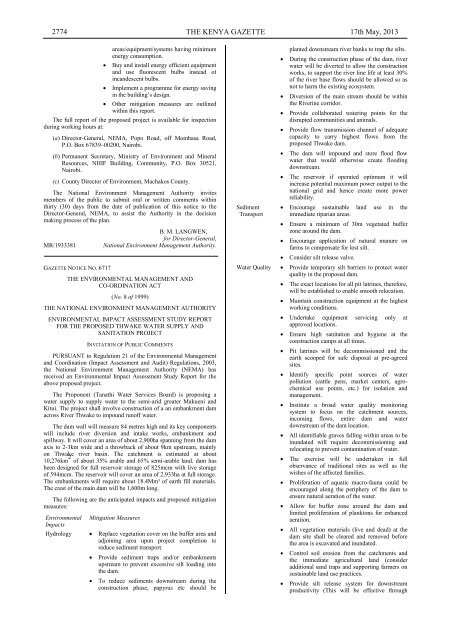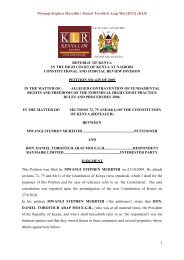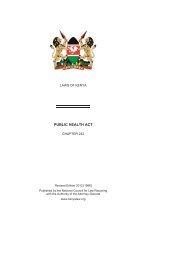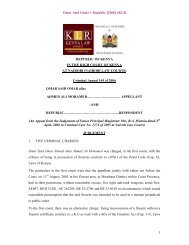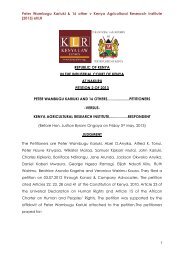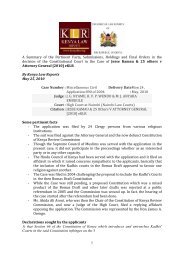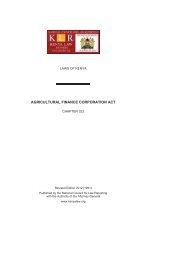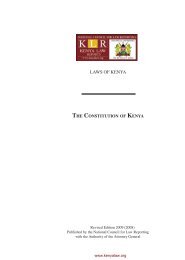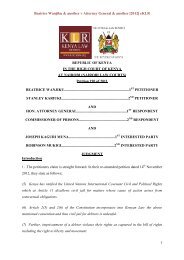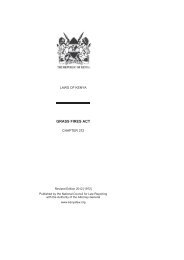2774THE KENYA GAZETTE 17th May, 2013areas/equipment/systems having minimumenergy consumption.Buy and install energy efficient equipmentand use fluorescent bulbs instead ofincandescent bulbs.Implement a programme for energy savingin the building’s design.Other mitigation measures are outlinedwithin this report.The full report of the proposed project is available for inspectionduring working hours at:(a) Director-General, NEMA, Popo Road, off Mombasa Road,P.O. Box 67839–00200, Nairobi.(b) Permanent Secretary, Ministry of Environment and MineralResources, NHIF Building, Community, P.O. Box 30521,Nairobi.(c) County Director of Environment, Machakos County.The National Environment Management Authority invitesmembers of the public to submit oral or written comments withinthirty (30) days from the date of publication of this notice to theDirector-General, NEMA, to assist the Authority in the decisionmaking process of the plan.MR/1933381GAZETTE NOTICE NO. 6717B. M. LANGWEN,for Director-General,National Environment Management Authority.THE ENVIRONMENTAL MANAGEMENT ANDCO-ORDINATION ACT(No. 8 of 1999)THE NATIONAL ENVIRONMENT MANAGEMENT AUTHORITYENVIRONMENTAL IMPACT ASSESSMENT STUDY REPORTFOR THE PROPOSED THWAKE WATER SUPPLY ANDSANITATION PROJECTINVITATION OF PUBLIC COMMENTSPURSUANT to Regulation 21 of the Environmental Managementand Coordination (Impact Assessment and Audit) Regulations, 2003,the National Environment Management Authority (NEMA) hasreceived an Environmental Impact Assessment Study Report for theabove proposed project.The Proponent (Tanathi Water Services Board) is proposing awater supply to supply water to the semi-arid greater Makueni andKitui. The project shall involve construction of a an embankment damacross River Thwake to impound runoff water.The dam wall will measure 84 metres high and its key componentswill include river diversion and intake works, embankment andspillway. It will cover an area of about 2,900ha spanning from the damaxis to 2-3km wide and a throwback of about 9km upstream, mainlyon Thwake river basin. The catchment is estimated at about10,276km 2 of about 35% arable and 65% semi-arable land. dam hasbeen designed for full reservoir storage of 825mcm with live storageof 594mcm. The reservoir will cover an area of 2,933ha at full storage.The embankments will require about 18.4Mm³ of earth fill materials.The crest of the main dam will be 1,600m long.The following are the anticipated impacts and proposed mitigationmeasures:EnvironmentalImpactsMitigation MeasuresHydrology Replace vegetation cover on the buffer area andadjoining area upon project completion toreduce sediment transport.Provide sediment traps and/or embankmentsupstream to prevent excessive silt loading intothe dam.To reduce sediments downstream during theconstruction phase, papyrus etc should beSedimentTransportplanted downstream river banks to trap the silts.During the construction phase of the dam, riverwater will be diverted to allow the constructionworks, to support the river line life at least 30%of the river base flows should be allowed so asnot to harm the existing ecosystem.Diversion of the main stream should be withinthe Riverine corridor.Provide collaborated watering points for thedisrupted communities and animals.Provide flow transmission channel of adequatecapacity to carry highest flows from theproposed Thwake dam.The dam will impound and store flood flowwater that would otherwise create floodingdownstream.The reservoir if operated optimum it willincrease potential maximum power output to thenational grid and hence create more powerreliability. Encourage sustainable land use in theimmediate riparian areas.Ensure a minimum of 30m vegetated bufferzone around the dam.Encourage application of natural manure onfarms to compensate for lost silt.Consider silt release valve.Water Quality Provide temporary silt barriers to protect waterquality in the proposed dam.The exact locations for all pit latrines, therefore,will be established to enable smooth relocation.Maintain construction equipment at the highestworking conditions. Undertake equipment servicing only atapproved locations.Ensure high sanitation and hygiene at theconstruction camps at all times.Pit latrines will be decommissioned and theearth scooped for safe disposal at pre-agreedsites. Identify specific point sources of waterpollution (cattle pens, market centers, agrochemicaluse points, etc.) for isolation andmanagement.Institute a broad water quality monitoringsystem to focus on the catchment sources,incoming flows, entire dam and waterdownstream of the dam location.All identifiable graves falling within areas to beinundated will require decommissioning andrelocating to prevent contamination of water.The exercise will be undertaken in fullobservance of traditional rites as well as thewishes of the affected families.Proliferation of aquatic macro-fauna could beencouraged along the periphery of the dam toensure natural aeration of the water.Allow for buffer zone around the dam andlimited proliferation of planktons for enhancedaeration.All vegetation materials (live and dead) at thedam site shall be cleared and removed beforethe area is excavated and inundated.Control soil erosion from the catchments andthe immediate agricultural land (consideradditional sand traps and supporting farmers onsustainable land use practices.Provide silt release system for downstreamproductivity (This will be effective through
17th May, 2013 THE KENYA GAZETTE 2775activation of silt washout valve).Water Loss Provide temporary lined channels fortransmission of river flows during constructionto prevent losses.EcologicalIssuesEnsure water abstracted for construction will bejust enough. Geological profiles throughout the areaproposed for inundation should be continuouslymonitored and areas of weaknessesstrengthened.Sub-surface water infiltration trends on affectedareas should be monitored over a period of timewith respect to effects on houses and otherstructures.Indigenous trees and shrubs that have low waterdissipation capacity should be encouragedaround the dam buffer zone to minimize loss ofwater through evapo-transpiration processes.Introduce economic and financial initiativestowards water saving and responsible utilizationby approved abstractions.Collaborated initiatives for compensation ofvegetation removed by planting a similarvolume of vegetation through communitygroups, i.e. local indigenous plant species.Estimated volume of biomass to be establishedfor the compensation.Initiate a dedicated tree nursery of indigenousplants for replanting.Reintroduction of disrupted species such as fish.Dam slope stabilization to facilitate aquaticanimals’ free movement.Sensitize the riparian communities on invasiveplants to be avoided.Early removal of the alien species throughmechanical/physical means as soon they arenoted.Monitoring water quality with respect tonutrient accumulation would be necessary.Develop and maintain a database of animal andplant species found in the dam area as a basisfor conservation and monitoring of newlyintroduced species in the future.Have an ecologist to oversee monitoring andmanagement of ecological changes around thedam ecosystem, in liaison with KWS. Liaise with <strong>Kenya</strong> Wildlife Service inmonitoring the new habitats and characteristicsof the wildlife migrating into the dam area.Establish community interests and values in theevolving ecological setting and enhanceeconomic benefits from the same.Consider fish ladders or by-pass channel tofacilitate fish movement.Consider crossing zones at the tail waters andacross the outfall into the proposed dam.Topography The construction works should incorporatelandscaping component.Maintain vegetated landscape as is the existingwith other dams in the cascade.The dam surroundings should be made safe andattractive for tourists.Material Sites All materials sites should be approved beforeuse.All materials sites should be rehabilitated uponcompletion of the works.Adhere to laid down regulations at all timesduring materials extraction.Abide by the principles of CSR on socialSocial andEconomicAspectsutilities during construction.Sensitize landowners on necessary land usechanges for dam protection.Undertake a comprehensive land acquisition andresettlement action plan (LAP & RAP) as abasis for compensations.Compensate appropriately any land acquired forthe main dam, buffer zones, water treatmentplant, sand traps, the pipelines and storagetanks. Include HIV/AIDS campaigns in damconstruction activities.Ensure the provision of condoms, voluntarystatus testing and use of ARVs.Advice communities on ways and means todevelop alternative grazing sites andcompensate the farmers for the crops affected.Facilitate farmers to access capital.Where possible, facilitate community-ownedand managed wildlife enterprise initiatives incollaboration with KWS.Use of a moat around irrigated crop fields tominimize hippo incursions into crop fields.Initiate collaborations with the communities andthe wildlife authorities on wildlife conflictmanagement.Enhance cultural preservation through CSRinitiatives.The full report of the proposed project is available for inspectionduring working hours at:(a) Director-General, NEMA, Popo Road, off Mombasa Road,P.O. Box 67839–00200, Nairobi.(b) Permanent Secretary, Ministry of Environment and MineralResources, NHIF Building, Community, P.O. Box 30521,Nairobi.(c) County Director of Environment, Makueni County.The National Environment Management Authority invitesmembers of the public to submit oral or written comments withinthirty (30) days from the date of publication of this notice to theDirector-General, NEMA, to assist the Authority in the decisionmaking process of the plan.MR/2436600GAZETTE NOTICE NO. 6718B. M. LANGWEN,for Director-General,National Environment Management Authority.THE ENVIRONMENTAL MANAGEMENT ANDCO-ORDINATION ACT(No. 8 of 1999)THE NATIONAL ENVIRONMENT MANAGEMENT AUTHORITYENVIRONMENTAL IMPACT ASSESSMENT STUDY REPORTFOR THE PROPOSED DEVELOPMENT OF REFUELINGTERMINAL AT WILSON AIRPORT (NAIROBI)INVITATION OF PUBLIC COMMENTSPURSUANT to Regulation 21 of the Environmental Managementand Coordination (Impact Assessment and Audit) Regulations, 2003,the National Environment Management Authority (NEMA) hasreceived an Environmental Impact Assessment Study Report for theabove proposed project.The Proponent (Gulf Energy Limited) intends establish a refuelinghydrant terminal at Wilson Airport. This will involve the constructionof operations offices, installation of fuel storage tanks, parking area forfuel bowsers, safety equipment and auxiliary civil works.
- Page 1 and 2: THE KENYA GAZETTEPublished by Autho
- Page 3 and 4: 17th May, 2013 THE KENYA GAZETTE 27
- Page 5 and 6: 17th May, 2013 THE KENYA GAZETTE 27
- Page 7 and 8: 17th May, 2013 THE KENYA GAZETTE 27
- Page 9 and 10: 17th May, 2013 THE KENYA GAZETTE 27
- Page 11 and 12: 17th May, 2013 THE KENYA GAZETTE 27
- Page 13 and 14: 17th May, 2013 THE KENYA GAZETTE 27
- Page 15 and 16: 17th May, 2013 THE KENYA GAZETTE 27
- Page 17 and 18: 17th May, 2013 THE KENYA GAZETTE 27
- Page 19 and 20: 17th May, 2013 THE KENYA GAZETTE 27
- Page 21 and 22: 17th May, 2013 THE KENYA GAZETTE 27
- Page 23 and 24: 17th May, 2013 THE KENYA GAZETTE 27
- Page 25 and 26: 17th May, 2013 THE KENYA GAZETTE 27
- Page 27 and 28: 17th May, 2013 THE KENYA GAZETTE 27
- Page 29 and 30: 17th May, 2013 THE KENYA GAZETTE 27
- Page 31 and 32: 17th May, 2013 THE KENYA GAZETTE 27
- Page 33 and 34: 17th May, 2013 THE KENYA GAZETTE 27
- Page 35 and 36: 17th May, 2013 THE KENYA GAZETTE 27
- Page 37 and 38: 17th May, 2013 THE KENYA GAZETTE 27
- Page 39 and 40: 17th May, 2013 THE KENYA GAZETTE 27
- Page 41 and 42: 17th May, 2013 THE KENYA GAZETTE 27
- Page 43 and 44: 17th May, 2013 THE KENYA GAZETTE 27
- Page 45 and 46: 17th May, 2013 THE KENYA GAZETTE 27
- Page 47 and 48: 17th May, 2013 THE KENYA GAZETTE 27
- Page 49: 17th May, 2013 THE KENYA GAZETTE 27
- Page 53 and 54: 17th May, 2013 THE KENYA GAZETTE 27
- Page 55 and 56: 17th May, 2013 THE KENYA GAZETTE 27


